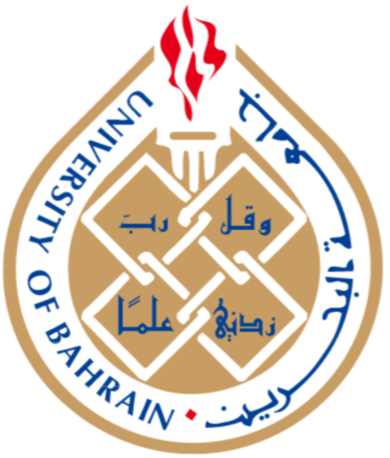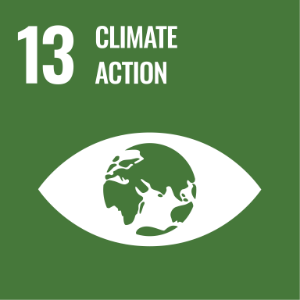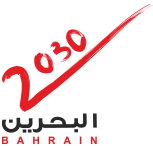Operations and Institutional Arrangement
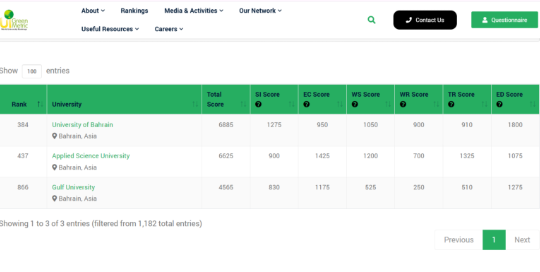
University of Bahrain Recognized for Leadership in Sustainability
The University of Bahrain (UoB) ranked first in the Kingdom of Bahrain in the UI GreenMetric World University Ranking 2023, and 25th globally in the Education and Research category. (Source: UI GreenMetric Rankings 2023 – Bahrain) , reflecting its strong performance in sustainability education, research, and campus operations. This achievement supports SDG 13 targets 13.1 (strengthen resilience and adaptive capacity to climate-related hazards) and 13.2 (integrate climate measures into policies and planning), as indicated by initiatives in renewable energy, waste and water management, sustainability-focused curricula, and institutional carbon monitoring.
Relevant SDG 13 Targets and Indicators:
- Tracking and reporting systems for energy, carbon emissions, and sustainability performance.
- UOB Contribution: Through GreenMetric reporting, the University of Bahrain provides transparent, data-driven evidence on carbon emissions, water consumption, and sustainable campus operations—supporting climate accountability and institutional planning.
Low-Carbon Energy Use and Carbon Footprint Assessment (Scopes 1 & 2)
The University of Bahrain is committed to measuring and enhancing the use of low-carbon energy sources on campus as part of its broader sustainability goals. This effort involves assessing and quantifying the total energy generated from renewable sources, such as: solar power, tracking annual electricity consumption, and calculating the University’s carbon footprint relative to its campus population. These data provide a clear indication of the University’s contribution to reducing overall energy-related emissions.
Within the Sakhir Campus, the primary sources of emissions are transportation (Scope 1) and electricity consumption (Scope 2). To minimize transportation-related emissions, the University provides free shuttle services to transport students and staff between buildings, colleges, and parking areas. Shuttle services are also available for students with special needs. The emissions associated with the on-campus bus fleet are included in the Scope 1 calculations.
Electricity consumption represents Scope 2 emissions and accounts for the total energy used across all Sakhir Campus facilities throughout the year. Energy use data are derived from the official electricity bills issued by the Electricity and Water Authority of Bahrain. In 2024, the Sakhir Campus recorded an annual electricity consumption of 47,047,107 kWh, primarily used for laboratory equipment, lighting, and cooling across academic and administrative buildings.
SDG 13.2: Integrate climate change measures into policies and planning
By actively monitoring carbon emissions, promoting low-carbon energy use, and implementing renewable energy initiatives, the University integrates climate action into institutional policies and campus operations.
Relevant SDG 13 Targets and Indicators:
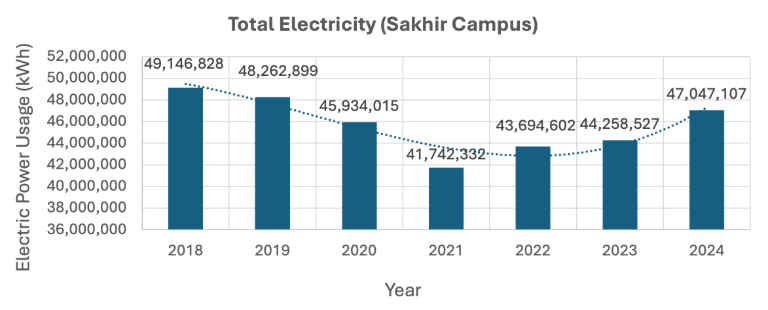
Annual Electricity Consumption in 2018-2024 (University of Bahrain Main Campus, Bahrain)
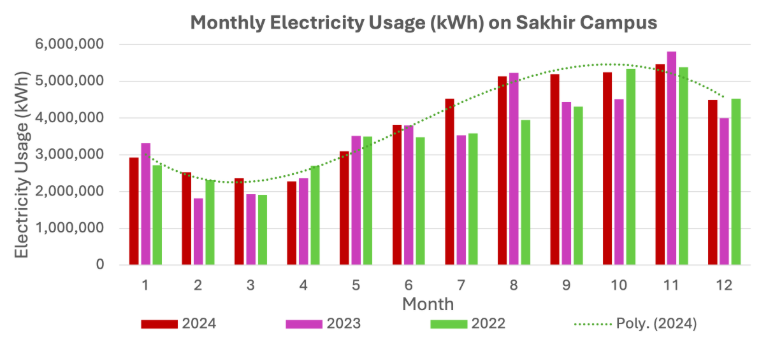
Monthly Electricity Consumption (kWh) (University of Bahrain Main Campus, Bahrain)
- A 6.3% increase in electrical energy usage was recorded in 2024 compared to 2023. However, the electricity used in 2024 was still lower than that in 2019 (pre-CODID-19) by 2.5%.
- Considering the university population (27,700 students + 1,300 staff) to be ~29,000, the electricity usage is 1,622 kWh/person.
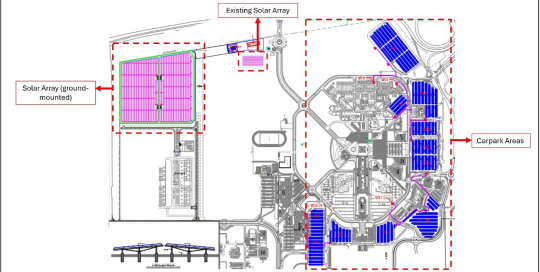
Solar Power Plant Project (46.2 MW)
University of Bahrain – Strategic Partnership with the Electricity & Water Authority (EWA)
Overview:
The University of Bahrain, in collaboration with the Electricity & Water Authority (EWA), is implementing a large-scale 46.2 MWp solar power plant on its Sakhir Campus. The project will generate approximately 70 GWh of clean energy annually, meeting nearly one-third of the university’s electricity demand through renewable sources.
Impact and Contribution:
This initiative is expected to reduce the University’s carbon footprint by 35,000 tons of CO₂ annually, marking one of the largest renewable energy projects within the higher education sector in the Kingdom of Bahrain. The project directly supports Bahrain’s National Renewable Energy Plan and national climate goals of 30% emission reduction by 2035 and net-zero carbon emissions by 2060.
Alignment with SDG 13:
The project contributes to:
- Target 13.1: Strengthen resilience and adaptive capacity to climate-related hazards.
- Target 13.2: Integrate climate change measures into institutional policies and planning.
- Target 13.4: Enhance commitment toward carbon neutrality and sustainable energy transition.
Outcome Indicators:
- On-campus renewable energy generation: 70 GWh/year
- Carbon emission reduction: 35,000 tons CO₂/year
- Renewable contribution to campus energy use: ~33%
Evidence and Reference:
- Official partnership with Electricity & Water Authority (EWA)
- Supports Bahrain’s Net-Zero by 2060 commitment
- Project completion expected Q3 2026
Relevant SDG 13 Targets and Indicators:
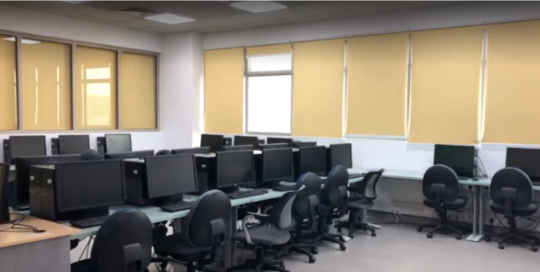
On-Campus Renewable Energy and Smart Efficiency Initiatives
Overview:
The University of Bahrain (UoB) has been operating an on-campus solar PV farm since 2012, featuring 2,088 polycrystalline panels with a total area of 3,400 m². Each panel is equipped with a micro-inverter for efficient DC–AC conversion and individual performance monitoring. In 2024, the PV system generated 435,150 kWh, accounting for 0.92% of total campus electricity consumption (47,047,107 kWh).
Energy Efficiency and Green Facilities:
Aligned with the University’s energy management plan, UoB has adopted low-energy technologies and smart systems across campus facilities.
- Green building upgrades: 53 out of 266 campus toilets have been renovated with infrared taps and dual-flush systems (Phase 1), with full completion planned by 2027.
- LED lighting replacement: Conventional fluorescent lamps and all street lighting columns have been upgraded to LED systems.
- Efficient equipment: Deployment of Energy Star computers, energy-efficient water heaters, and 6-star rated split A/C units enhances energy performance and emission reduction.
Impact and SDG Alignment:
These initiatives demonstrate UoB’s commitment to SDG 13 targets:
- 13.1: Strengthen resilience and adaptive capacity to climate-related hazards.
- 13.2: Integrate climate measures into institutional policies and planning.
Key Indicators:
- Renewable energy generated (2024): 435,150 kWh
- Share of renewables in total energy use: 0.92%
- Annual carbon emissions reduction through energy efficiency measures
- Progressive retrofitting toward smart, sustainable campus infrastructure
Evidence:
- UoB PV Farm operational data (2024)
- Campus energy management and green building renovation plans
Relevant SDG 13 Targets and Indicators:
